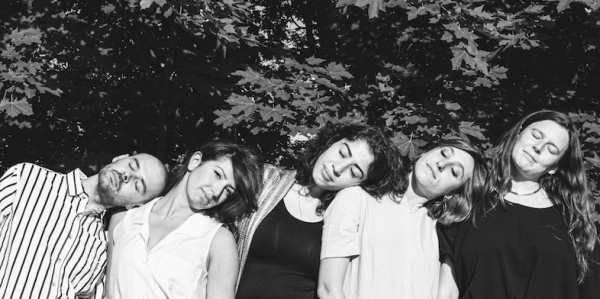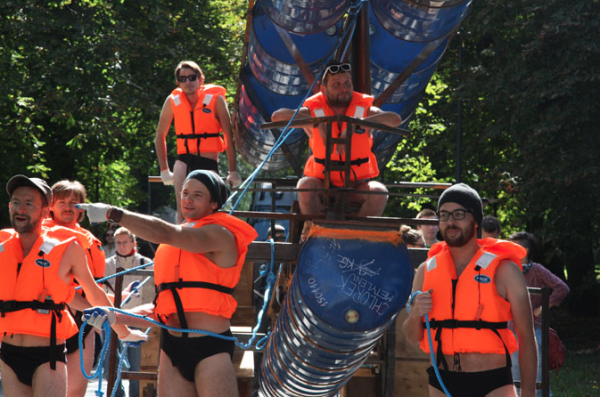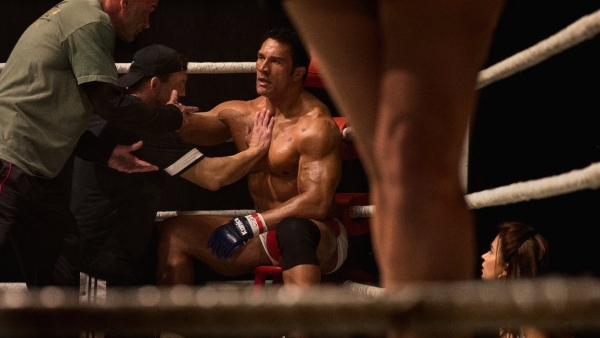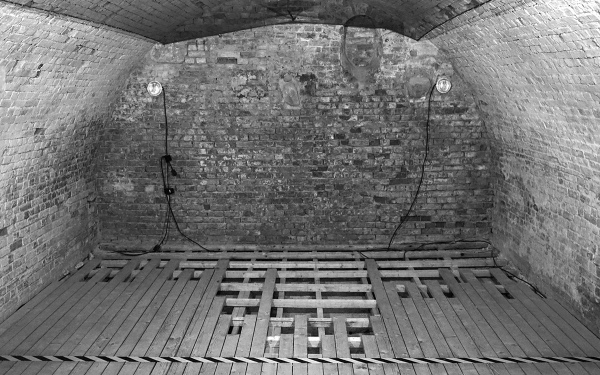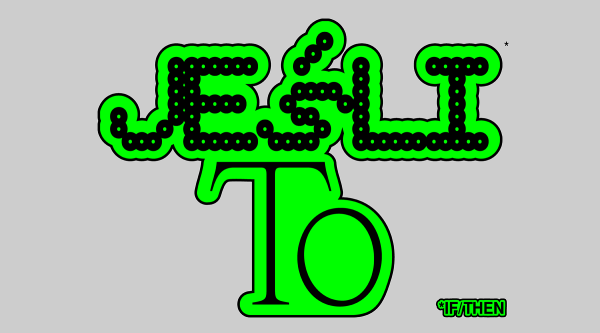Ministry of Alternative Transport
Francis Thorburn talks to Paulina Jeziorek about alternative transportation, rituals as arational forms for building relationships, and romantic machines run by human muscles
-
You’ve proclaimed yourself a Minister of Alternative Transport. What exactly is the ministry you’ve created?
-
It’s a kind of new research institution for the future of transport. Everything is experimentation hopefully leading to the discovery of a revolution in transportation. Two situations or thoughts gave me a couple of ideas before I created the Alternative Transport Network (ATN). About five years ago, I heard on the radio that there won’t be any more helium in like five or six years. It will be totally obsolete. Totally weird, but it shows you something – like extreme consumption. So helium will be gone...
-
-
-
Do you think it’s because of the amount of balloons in entertainment parks?
-
Possibly... I wanted to create a project based on helium. We may be the last generation to experience balloons. I came up with the idea to make a huge balloon, or a series of huge balloons that would be equal in mass to the body of an individual. So, you have to find out how much you weigh compared to the volume of the balloons, so that, combined, you can bring gravity close to zero. You could tie the balloon to your body and your weight becomes like ten grams. The balloon would be equal in floating volume to your weight. So you could jump, and float for one mile, because you weight nothing.
-
-
-
How high can you go?
-
It depends on how windy it is. I never did that performance, but I did drawings of it. The idea was to travel the whole of England simply by jumping across it. Of course, later, that idea led me to consider other expendable resources like petrol and so on. I was engaged with another project at the time. It was a parody institution called the South London Institute of Common Sense. It was a parody university, which used performance lectures as modes of teaching. It was somewhere in between lectures and performance art. It was totally unsuccessful, because it was actually my first curatorial project. I invited artists to perform, but I didn’t know exactly what I wanted.
-
-
-
Why did you want to experiment with an institution?
-
It was the beginning of my critique of institutionalization and the boundaries of what is acceptable and unacceptable within an institution. I was wondering how you could expand the ideas of how an institution should be structured. But it was pointless. Fundamentally, absurdity was the main mode of critique. To make something absurd is to highlight that it is not working properly. At that time, I was finishing my studies and it was a complete battle with the university to make my work possible. They had no space or resources, and bureaucracy was a huge barrier to the process of creating art or even an idea, for that matter. The momentum was lacking. The university in England is just a moneymaking machine. So, the project was inspired by my frustration over this experience. That idea then became really important to me metaphorically for the whole of society. After a couple of years, I began thinking about a revolution not only in terms of the university, but also for all of society. After all, the political system is the biggest bureaucratic system of control in the world...
-
-
-
So you became an anarchist?
-
Something like that. But a happy anarchist. I never wanted to cause chaos. I only wanted to bring about conversation through completely positive actions and alternative experiences. Everything that is alternative is opposed to the mainstream, which is aligned with a system that controls the way we formulate our opinions and our lives. So, it was all about offering new alternatives that were not only positive, but also humorous, because I love comedic imagery. It brightens my life. Absurdity and humor. That was the main tool I was using to seduce the public during these guerilla actions.
-
-
-
So the two mentioned actions became a background for your interest in transportation as well as alternative institutions? That’s why you became a Minister of Alternative Transport?
-
Yes, that’s why I created the Alternative Transport Network (ATN). And it is very directly parodying the system of Transport for London (TFL). ATN is its rival. This is how I imagined it. We could become the alternative to mainstream transportation in London.
-
-
-
The vehicles that you construct require a lot of physical strength. And we as a society are not so strong.
-
There is the idea of human hamsters... I am playing with the idea of man. I am challenging it because I do not know how the identity of man fluctuated in the last 100 years. And that’s a very personal question.
-
-
-
You mean the identity of man in general, or the identity of the working class man specifically?
-
My work has this working class undertone about heavy work, but, actually, it is more generally about the loss of labor in everyday life due to technological advances. I am reminiscing about the physicality of man in general. It goes much farther back, in fact. I look back at times where you had to trust your physicality – pre-gun times. So, this question of man and the power of man and masculinity relates to what we do now as contemporary man, especially if we don’t want to be part of a system that can offer us little more than a job in an office. How do you create your own job? And this is probably how this role of playing the Minister of Alternative Transport came about.
-
-
-
Physical strength is part of the nature of a human being. It would be strange and dangerous to forget it and to become dependant only on technology. But on the other hand – technological progress is unstoppable.
-
Yes. So this is where the point of the critique is completely fallible. But the battle is totally romantic. It is like building this sculpture. I do it pretty much on my own (only with occasional assistance). It’s a kind of idealistic, utopian, and romantic moment when I try to do something inspiring or at least to put forth a question. When I say it is fallible, it is also pointless. It is futile. And the futility is a reflection of how I feel about the position of the world. Deep down I am totally cynical, actually. I would like to challenge money. But it is impossible. How can you challenge such systems? So you have to laugh about it.
-
-
-
So the vehicles you are making, you’ve been making for how long?
-
For 5 years...
-
-
-
And you make them out of recycled materials?
-
It is a combination of bought and recycled material. I have set up a kind of relationship with the British network railway, the national railway, and they give me an endless supply of these huge wooden wheels. This is a mutually beneficial relationship. They don’t want them, I take them. And they have hundreds of them. So every time I need to make a piece, I take one. They have metal ones, wooden ones...
-
-
-
So the Minister of Alternative Transport gets endless supply of spools from the National Rail?
-
Then I find a lot of material, because I work for a gallery as an art handler/fabricator, making stuff for them. Building things. At the end of an exhibition, I can take all the stuff that is left over.
-
-
-
So it is kind of a recycled art?
-
Yeah (laughter). But recycling is not a conceptual point. It is a point of necessity, because I don’t sell my artwork. Still, it has an aesthetic point of view, as well. It just happened like that, because I do not have any money to buy materials. And, for example, I never paid for a studio, because it is impossible. I went and created a relationship with property owners. So this is rather like a non-monetary system. No money involved. For the last one and half years, I’ve been working with the biggest property developer in London, and they just gave me a huge, empty space. When somebody wants to buy that one, they’ll give me another one.
-
-
-
You’re making interesting deals...
-
Yes. And it is working. It is a funny story, because I was working in a huge warehouse that was owned by the city. The area became trendy, because there was a lot of artistic activity and music going on. Then, all of a sudden, the recession came, and the government told the local councils: “You have to make money for your own budget.” This meant they had to sell or rent properties in order to make money for their local budgets. So, they sold the warehouse that we were in to a developer, who then knocked it down completely. The problem was they gave me only 24 hours notice to get out. I had 5 vehicles at that time. I went back to my university that I graduated from and asked them, “Help me! Can I bring my work to you and have it in your car park until I find something?” Finally, they said yes. I was trying to negotiate with different owners to find a new place. Eventually, the Workspace Group—the property developer—agreed. And it is totally working the bureaucratic system set up by the government, too. We found a way for them to save money by me being inside the building. For free. So I pay nothing and they pay nothing. According to British law you have “business rates.” Every company has to pay tax on a building whether it is empty or not. But if they give it to someone charitably, they do not pay this tax. We worked it out. And now I know I have a secure position with these guys, because I am helping them. They have huge spaces. I was in one space for eight months. Now, I am in another space for eight months. Every time they sell one, they promise me they will find me a new building in London. So I just have to be able to move my vehicles to the next place.
-
-
-
Let’s talk about your vehicles. Most of them are made for city transport?
-
It’s localized. The things are dysfunctional. Most of them do not take passengers. They only take people to power them. There is only one passenger and that’s the person steering. The rest of the people are either acceleration or breaks because I do not know how to make breaks. So everything is done by men. Did you see the Mobile Picnic Pavilion I made? It had no breaks – just one emergency break. It weighed four tons. And it took 20 people to hold it back when you were going down the hill...
-
-
How much adult male strength is needed for stopping four tons weight on wheels? Now, we know it takes 20 people. And to pull it up?
-
The same amount – but everybody was dead... (smile)
-
-
-
And to pull it on a flat surface?
-
Twelve people, but it is difficult to stop it with twelve people. I really struggled with that piece because it needed so many people.
-
-
-
Always men?
-
Picnic Pavilion was the only one that used a combination of men and women. It is not conceptual. It is entirely aesthetic. It is something that visually causes no confusion. Like the underwear, just black underwear…It’s more coherent, all men in the same outfit. And I even went to the point, on my last piece, where I had only skinny guys. I was trying to specify the aesthetics even more so as you have this uniformity.
-
-
-
The vehicles you make are visually epic...
-
Epic, but also kind of pathetic. We are skinny artists with no muscles. Completely pathetic men, wearing stupid little underwear like 7-year-old boys.
-
-
-
I’m not sure if I perceive it that way. I remember another project of yours called The Drag. You were pulling a stone from the seashore to the town…
-
It was a process-based project. A collaboration with another artists and a friend of mine, Joel Gray. Earlier, I was talking about Aztecs pulling stones. They were doing it with logs. Putting the tree log under the stone…I made The Plank piece with their system, but using barrels instead of logs. I was talking with Joel about the idea of pulling. We wanted to make a sculpture and a drawing. We decided to do the project in the South of England, in Folkstone, where the White Cliffs of Dover are. Beautiful white cliffs. We decided to make a project taking a stone directly from a cliff, pulling it out and dragging it. And this was a chalk stone. So, while dragging it, we made a line. It left a 50-60 cm mark from the position we took it from, to the position where we took it.
-
-
-
And on the way out was it losing weight?
-
Yes. Thankfully. It took us five hours to make a half hour journey. The first one was about 600-700 kg. Eight guys were pulling it. But the resistance of the surface added a lot of weight.
-
-
-
Then you are not so pathetic...
-
Totally pathetic. We were moving a hundred meters an hour…We were like: “Ok, one two three,” then five meters forward and then stop and again. We were totally dead until it got smaller. After three hours, we could drag if for 50 meters... And we were rotating the stone. We were dragging it across the cliff area, so the texture of one side represents that part of a journey. Then, we turned it when we got to the road... Later we turned it again. So in the end we had a three-sided sculpture that weighed less than 40 kilos.
-
-
-
What was the idea behind the pulling?
-
It was a three-stage process: the performance of pulling, then the process of making the drawing and sculpture. In the end, we had a ritualized object. The drawing is a memory and the sculpture is magic created by the ritual and history of the action. It looks like an artifact. We made a second one with 25 men and a stone weighing over a ton.
-
-
-
What is a sculpture for you?
-
The sculpture is a byproduct of the performance. They are produced as a result of the performance. But in relation to the contemporary art world, or the art market, in particular, I like the idea of a sculpture being something that you cannot have. It is not valuable. It’s too big and transient. Making such things opposes the market. It is not something havable, it is junk. And it is ludicrous to make something for so long. Like, in Wroclaw, I worked six weeks and the performance lasted two hours. Then, the exhibit was shown in the gallery for three weeks and then it was taken apart. It costs a lot of money, time, energy, but not even big institutions can deal with it in the long term. The piece I am doing in the CSW Castle may also be destroyed, because of its size and it does not have an inherent value. Its value is in the performative part. It is totally scary for an institution to think about having to keep something like that.
-
-
-
You said about Wrocław where you created a vehicle for the festival Out of Something. You often work in Poland?
-
I spend a lot of time here. I’m doing a curatorial project in London, too. I was running a gallery there for three and a half years. I was here four years ago to assist Stach Szabłowski in his exhibition Establishment. In the show, I met lots of great young Polish artists. I was working with them or usually helping with their work…I also worked with Olaf Brzeski. He is a good friend of mine. We showed his works in the gallery in London two and a half years ago and last year in the South of England. So, mostly it’s been curatorial work, exchanges between Poland and England. We had a plan to make a residency exchange. I would organize big spaces for Polish artists coming to England and vice versa, but we didn’t get any funding.
-
-
-
But you also make your own projects in Poland. Why did you use a Mały Fiat 126p to create your vehicle for the festival called Out of Something in Wroclaw?
-
I tried to think of using something that would open up a certain door. Something generally known to all Poles. I was wondering how my work would work in Poland.
-
-
-
And?
-
Totally different than in England. Different reactions. I got lots of responses, but they were much more conservative. It is interactive in London. When I’ve done stuff in other places like Scotland or Portugal, there’s been direct intervention from the public, people were shouting at you like: “What are you doing?” “Why are you doing it?” They were honking their horns…In Poland, it was silence. It was positive, but conservative. No one wanted to put themselves out there to ask what’s going on. And we went down the main street straight into the city...
-
-
-
No interaction?
-
People were taking photographs, but keeping their distance, except for the people that were part of the gallery audience, who were very active. But the main target of my performances are people who don’t expect to see such a thing at the time. I was confused about how to respond to that. Normally you create a relationship. I was trying to figure out how I felt after not being able to build a relationship with the members of the public that I am so used to building. To be honest, the sculpture was more successful than the performance. Now, I am trying to do something that is more about the action. Go deeper into the spectacle.
-
-
-
When I look at your art, I can see in your work some connotation of ritual and religion.
-
Yeah. I am thinking about the loss of religion in society. I have this second body of work that is using movement, like the vehicles, but without vehicles.
-
-
-
The works have a connection with Christianity...
-
Totally. My father is a vicar.
-
-
-
A Protestant or Catholic one?
-
Protestant. I would not be allowed to say that if he was Catholic. I would be illegitimate.
-
-
-
We Polish people would not be so shocked anymore...We are already familiar with such situations and are used to them...
-
Well... I got married in Poland and after the wedding we heard a rumor that the priest had two children. I found it hilarious... So, I was brought up with rituals all around me all the time. I am not Christian. But I am interested in the role of a body that is like the church or a body that gives ethical and moral guidance and creates community. Not in a propagandistic way. The church, at the moment, is totally polluted. But, in general, it is about the ideals, the beginning of religion. What are rituals? What is the purpose of rituals? It is kind of about being together. To understand and have people around you who agree with you.
-
-
-
Recently I read something interesting. According to transpersonal psychology that examines spiritual aspects as a part of human nature, and is therefore needed for basic health, there are certain behaviors that are considered destructive by western science. Like cutting or starving yourself, which, in other cultures, especially tribal ones, are rituals considered necessary for the transformational processes and are supported by communities as rites of passage–necessary actions in order to mature, to develop an identity and so on... Like these are ways to meet death, descend to hell, in order to be able to transform... But, in western cultures, there is no social support for individual transformation, passing through different stages…On the contrary, identity problems or transformations are considered abnormal and a sign of illness...
-
Yes. People who are stuck in between, they are told they are crazy. So, for them, it is impossible to find spirituality, to mature, to find their way. They start to think that they are crazy. Self-condemnation...
-
-
-
You think it would be important to create such supportive structures...?
-
Yes. Or, at least, to recognize the qualities that are important to religion and to try to reinvent them again. To bring them back together without the stigmatization of an institution. The performances I do are operating this way as rituals of togetherness. But it is also more abstract than that. It is about critiquing the loss of belief. Not only religious beliefs... But values in general like honesty and truth... In this way, I’m looking primarily at England. I could say, in comparison to Poland, which is, on paper, 90% Catholic, England is aggressive, anarchic and unstable, just on a basic understanding level between people. Let’s take the guys called “dresiarze” (Polish social group and subculture similar to hoodies or chavs in England or USA) here. I love them. They are so friendly. You can find middle ground with these guys. But I feel totally unsafe in parts of the UK with some people, like people with money, rich “good citizens.” I feel totally unsafe. I would not trust them. But I want to trust. I miss the idea that you could put faith in a fellow person blindly. It is totally romantic. So there was this naivety in my head. I was frustrated with the sickness of society. And also, I feel like I know where the blame lies. Right on the top, not right at the bottom. And that’s a global thing, as well. Fundamentally, the fact that people do not respect each other is because of the position they’ve been put in by institutions or governments. People with money rely on people who have no money. And they sell them shit, because people are not using their heads, and the guys at the top are taking advantage of this lack of thinking. Another problem in the UK is the problem of family. It used to be that the church and governments would encourage the family structure through social propaganda, but due to the slow shift of values, these family-centric campaigns have decreased massively. As a result, there has been a breakdown in family structures, and this causes some kind of social imbalance. It is such a big topic. And we should address it. In the past, it would have been the leader of the country, or the church, that would seriously address issues like this. I do not know if we need a big hero to change people’s minds, maybe just a lot of individuals that work within the masses trying to change the way that people can think. That’s one way to change mass ideas. Although, now, it is impossible to think about how you could realistically create something new to regain things we’ve lost. If people are more spiritually in tune or in touch with a genuine value system, that can change your response to life and people. Although my work is not necessarily a spiritual experience, it acts as an unexpected and positive interruption in the lives of those who encounter it. So, in that sense, I consider my vehicles really useful things. A positive interruption can change something in people’s heads without them realizing it. You go through London with the vehicles, and if you take a main road in the center, thousands of people see them. I really think if they are not asking themselves questions, they respond to it positively. We never had anybody respond negatively. It is always positive or inquisitive.
-
-
-
What kind of a project are you doing here at the Ujazdowski Castle?
-
I am making a voyage from the castle to the Wisła and across the Wisła to Praga using a man powered amphibian land and water vehicle. It will be pulled by eight or ten guys. I do not know how much of it will be able to get in the water without it sinking, if it does not sink straight away. And we invite participants from the general public to help guide the process of the vehicle and the guys operating it.
-
-
-
Why did you decide to cross the Wisła?
-
It is a romantic idea to cross the river. It is about spectacle, romanticism, trying to do something that seems impossible. With regard to this sculpture, I am trying to make it as heavy as possible. It is a huge piece of metal. I want to make it seem impossible and spectacular. To entertain, in some way. To do something that looks like it should not be done. It is also about building something alone, with a huge amount of work... And in the end you are just crossing the river...
-
-
-
How do you know it is going to float?
-
I was working intuitively, and had somebody make calculations...So, I know it should float if I did not make any holes in the barrels while I was welding the metal. But, in fact, I know that I made a few holes. So, it is possible that it will fail, because of my construction abilities or lack thereof. You can see if there is a hole, because, while you are welding, the chemicals from the barrel burn and you can see a flame. So I think I made about ten holes...maybe more...they are tiny, little ones. But I do not know exactly where they are. I still think we will get to the other side. Or maybe it will start to sink, which could also be absolutely fantastic...
-
-
-
The interview was held during the residency of Francis Thorburn at the Ujazdowski Castle Centre for Conetmprary Art in 2012.

